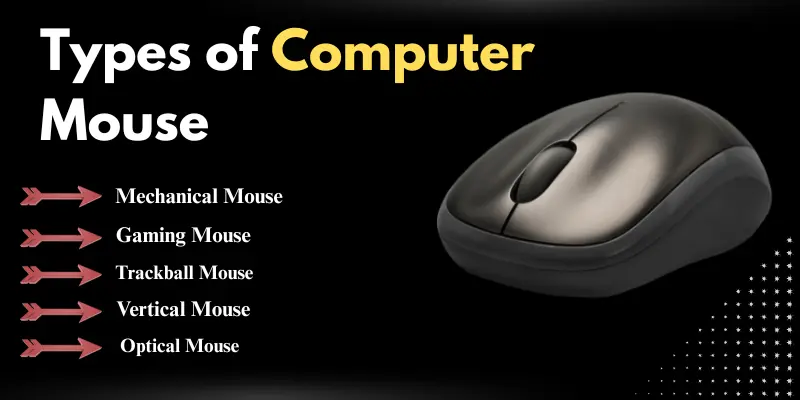Types of Computer Mouse: Which One Should You Choose?
Published: July 29, 2025
Have you ever considered which mouse best fits your needs? With many options available today, choosing the right one can make a big difference in how you work, play, or browse. Whether you’re a gamer, student, or office worker, selecting the right mouse can improve your comfort, speed, and efficiency. Before choosing, it’s also helpful to know the advantages and disadvantages of a computer mouse. This article will guide you through the different types of computer mouse and help you pick the one that suits your needs best.
What is a Computer Mouse?
A computer mouse is a small device that you use to move the cursor on your computer screen. You move the mouse with your hand to click, select, drag, and open files or programs. It connects to your computer by cable, Bluetooth, or a USB receiver.
Consider it a remote control for your computer. A mouse makes it easier and faster to play games, browse the internet, and conduct schoolwork.

Types of Computer Mice
Computer mice come in many shapes and styles to match different needs. Whether you’re working, gaming, or browsing, there’s a mouse designed just for you. Here’s a list of the most common types:
1. Mechanical Mouse
A mechanical mouse was one of the first forms of computer mice. It detects movement by placing a rubber or metal ball underneath. As you roll the mouse across a surface, sensors inside track the ball’s movement and move the cursor on the screen. For optimal operation, these mice require a level mouse pad and should be cleaned regularly, as dust can clog the sensors.
Pros:
Here are some of the main advantages:
- Simple and low-cost
- Works without batteries
- Basic functionality for everyday tasks
Cons:
However, there are also a few disadvantages you should know:
- Needs regular cleaning
- Slower and less accurate than modern mice
- Doesn’t work well on smooth or uneven surfaces
2. Optical Mouse
To detect movement, an optical mouse shines light on the surface beneath it, commonly from an LED. Instead of a ball, it detects movement by taking photos of the surface and detecting changes as you move the mouse. Optical mice perform effectively on most surfaces and require less upkeep than mechanical mice.
Pros:
Let’s look at some of the key benefits:
- Accurate and smooth tracking
- Works on many surfaces without a mouse pad
- Low maintenance, no moving parts
Cons:
Still, there are a few drawbacks to note:
- It may not work well on very shiny or glass surfaces
- Uses batteries or USB power (for wireless models)
- Slightly more expensive than mechanical mice
3. Wireless Mouse
A wireless mouse connects to your computer without using any cables. It sends signals wirelessly via Bluetooth or a tiny USB receiver. This allows you to move the mouse with greater ease without being limited by cables. Wireless mice are ideal for keeping your desk neat and using them with laptops on the road.
Pros:
Check out the advantages it offers:
- No cables, more freedom of movement
- Cleaner and less cluttered workspace
- Easy to use with laptops and portable devices
Cons:
Let’s look at some of its downsides:
- Requires batteries or charging
- It can sometimes have a slight signal delay
- Usually more expensive than wired mice
4. Wired Mouse
A wired mouse connects to your computer using a cable, usually through a USB port. This direct connection means it doesn’t need batteries and often has a stable, fast response time. Wired mice are simple to use and are popular for tasks where quick, precise movements are important, like gaming or detailed work.
Pros:
These are some things people like about it:
- No need for batteries or charging
- Reliable and fast connection
- Usually less expensive than wireless mice
Cons:
It’s not perfect, here’s why:
- Cables can limit movement
- The desk can get cluttered with wires
- Cables can wear out or get damaged over time
5. Trackball Mouse
A trackball mouse remains fixed while you move a huge ball on top with your fingers or hand to control the cursor. This style saves desk space and enables accurate control without using your entire hand. Trackball mice are ideal for persons who have limited workspace or prefer minimal wrist movement.
Pros:
These are some things people like about it:
- Saves desk space
- Reduces wrist movement and strain
- Offers precise cursor control
Cons:
Now, let’s explore the limitations:
- Takes time to get used to
- It can be harder to perform fast movements
- Requires cleaning of the ball and sensors
6. Gaming Mouse
A gaming mouse is built specifically for video games. It usually has additional buttons, high-precision sensors, and adjustable features such as changeable DPI (sensitivity). These mice enable gamers to react faster and play better by improving control and comfort during extended gaming sessions.
Pros:
Let’s explore what makes it a great option:
- High precision and accuracy
- Extra programmable buttons for shortcuts
- Ergonomic design for comfort during long use
Cons:
But there are also some weak points to consider:
- More expensive than regular mice
- It can be complex for basic users
- Some models require software installation
7. Vertical Mouse
A vertical mouse is designed to maintain your hand in the natural, handshake posture. This design decreases wrist strain and helps to avoid repeated stress injuries. Vertical mice are ideal for people who spend a lot of time on the computer and wish to be more comfortable.
Pros:
These are some features that stand out:
- Reduces wrist and forearm strain
- Promotes a more natural hand position
Cons:
A few cons are worth mentioning too:
- Takes time to get used to the different grip
- Usually larger and bulkier than regular mice
- Can be more expensive than standard mice
8. Trackpad (Touchpad)
A trackpad (also called a touchpad) is a flat, touch-sensitive surface that detects finger movements to control the cursor. It is usually found on laptops and some keyboards. Trackpads let you move the cursor, navigate, and perform actions like zooming or clicking without needing a separate device.
Pros:
These benefits make it worth considering:
- Built into laptops, no extra device needed
- Supports multi-touch gestures for easy control
- Compact and portable
Cons:
These issues might affect your decision:
- Less precise than a mouse for detailed work
- It can cause finger fatigue during long use
- Limited surface area can restrict movement
9. 3D Mouse
A 3D mouse is a specialized device that allows you to control things in 3D space. It is commonly used by designers, engineers, and 3D artists. Unlike a normal mouse, it allows you to effortlessly move, rotate, and zoom 3D models, making complex design work more efficient and faster.
Pros:
Here are some strong points you should know:
- Provides precise control over 3D objects
- Improves workflow for designers and engineers
- Reduces the need for keyboard shortcuts
Cons:
But there are also some weak points to consider:
- Expensive compared to regular mice
- Not useful for everyday tasks
- Has a learning curve for new users
10. Foot Mouse
A foot mouse is a device that is controlled by foot movements rather than hand motions. It allows users to move the cursor and click with their feet, which is useful for people who have hand injuries or want to lessen hand strain. Foot mice free up your hands for other activities.
Pros:
Let’s look at some of the key benefits:
- Helps users with hand disabilities or injuries
- Reduces hand and wrist strain
- Frees up hands for multitasking
Cons:
Still, there are a few drawbacks to note:
- Takes time to learn how to use it effectively
- It can be tiring to use your feet for long periods
- Less precise than a traditional mouse
11. Rechargeable Mouse
A rechargeable mouse is a wireless mouse with a built-in battery that can be recharged by a USB connection or charging port. It saves money by not using disposable batteries and is environmentally beneficial. Rechargeable mice provide the convenience of wireless use without the need for regular battery changes.
Pros:
Check out the advantages it offers:
- No need to buy disposable batteries
- Environmentally friendly
- Convenient to recharge anytime
Cons:
Let’s look at some of its downsides:
- Needs to be charged regularly
- Can stop working if the battery drains completely
- Usually more expensive than regular wireless mice
12. Laser Mouse
A laser mouse employs a laser beam to detect movement with high accuracy. It performs well on most surfaces, including glass and polished desktops, where other mouse may struggle. Laser mice are popular among users who require precise tracking for activities such as graphic creation and gaming.
Pros:
Check out the advantages it offers:
- Very precise and sensitive
- Works on many types of surfaces
- Ideal for detailed tasks like design and gaming
Cons:
Now, let’s explore the limitations:
- It can be more expensive than optical mice
- Sometimes too sensitive for casual users
- May use more power than standard mice
Conclusion
We hope you’ve learned a lot about computer mice and how to choose the one that best suits your needs. Whether you’re a gamer, a student, or a regular user, selecting the proper mouse just got easier!
But wait — did you know that your keyboard can be just as important in boosting your productivity and comfort? From ergonomic designs that prevent strain to hidden pitfalls that might be slowing you down, our detailed guide on the advantages and disadvantages of keyboards reveals everything you need to know. Don’t miss out on these essential insights that could transform the way you work and play.
Frequently Asked Questions [ FAQs ]
Here are some frequently asked questions to help you understand better.
Here are 4 common types of computer mouse:
- Mechanical Mouse – Uses a rolling ball to detect movement.
- Optical Mouse – Uses LED light to track movement on most surfaces.
- Wireless Mouse – Connects to the computer via Bluetooth or USB receiver without cables.
- Laser Mouse – Uses a laser for more precise tracking, even on shiny or glass surfaces.
Here are the main types of computer mouse you should know:
- Mechanical Mouse
- Optical Mouse
- Laser Mouse
- Wireless Mouse
- Wired Mouse
- Virtual Mouse
- 3D Mouse
- Foot Mouse
- Rechargeable Mouse
- Vertical Mouse
- Gaming Mouse
Yes, an optical mouse is better for most people. It moves more smoothly and needs less cleaning compared to a mechanical mouse.
A trackpad is not the same as a mouse, but it serves a similar purpose. Instead of using a separate device, you swipe, tap, or click on the flat surface. It is typically included with laptop computers and functions similarly to a mouse in terms of cursor control.
Here are five common uses of a computer mouse:
- Pointing and Clicking: You use the mouse to move the cursor and select items on the screen.
- Dragging and Dropping: It helps you move files or objects by holding and dragging them.
- Scrolling: The scroll wheel lets you move up and down through pages or documents easily.
- Opening Files or Programs: Double-clicking with the mouse opens files, folders, and apps.
- Gaming and Drawing: Many users use a mouse for playing games or drawing in graphic software for better control.

- Be Respectful
- Stay Relevant
- Stay Positive
- True Feedback
- Encourage Discussion
- Avoid Spamming
- No Fake News
- Don't Copy-Paste
- No Personal Attacks

- Be Respectful
- Stay Relevant
- Stay Positive
- True Feedback
- Encourage Discussion
- Avoid Spamming
- No Fake News
- Don't Copy-Paste
- No Personal Attacks





